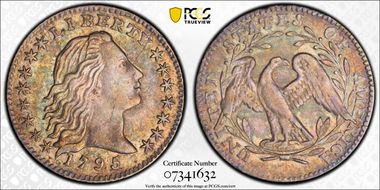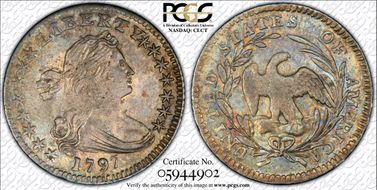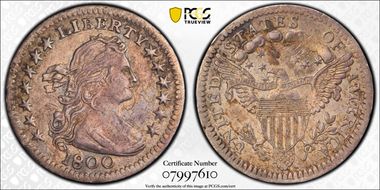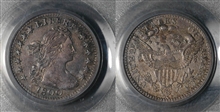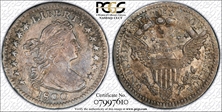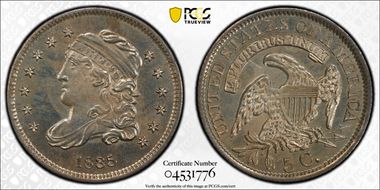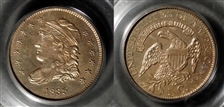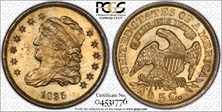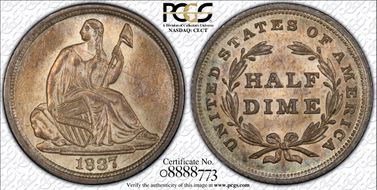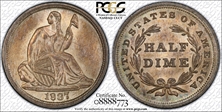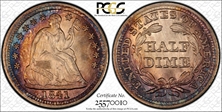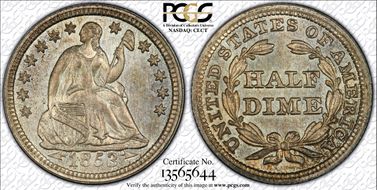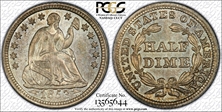Gobrecht's Raisinet Collection 的钱币相册
Lots of detail for VF25, Old Green Holder, R.4 PQ A large question surrounding this coin is whether or not President Washington supplied the silver. Research by Joel Orosz and Carl Herkowitz published in the 2003 Amer. Journal of Numismatics cited a memorandum by John A. McAllister, Jr. who related his interview with Chief Coiner Adam Eckfeldt: "In conversation with Mr. Adam Eckfeldt (Apr. 9, 1844) at the Mint, he informed me that the Half Dismes...were struck, expressly for Gen. Washington, to the extent of One Hundred Dollars, which sum he deposited in Bullion or Coin, for the purpose. Mr. E. thinks that Gen. W. distributed them as presents. Some were sent to Europe, but the greater number, he believes, were given to friends of Gen. W. in Virginia. No more of them were ever coined." Eric von Klinger in a June 13, 2005 Coin World review of the article entitled "Document Details Half Disme: Confirms that G. Washington was Source of Silver," wrote: "General Washington did indeed deposit silver for the 1792 half dismes." Orosz responded in a July 4, 2005 letter to the editor that: "We never claim in our article that we have proved that President Washington provided the silver used to strike the half dismes, as both the headline and the first sentence of von Klinger's article flatly state. In our article, we conclude that while the great preponderance of the evidence points toward Washington as the silver provider, the pieces of evidence that could prove he was - Washington's diary for 1792 and Acting Chief Coiner Henry Voigt's July 1792 account book - are unavailable. Washington was a long-time diarist, but the press of his presidential duties prevented him from keeping a diary in 1792. Voigt did keep an account book, but it was lost about a century ago, and no one knows where it is, or if it even still exists. Therefore, while the authors believe that all of the available evidence points to Washington, we cannot prove he was the donor beyond the shadow of a doubt."
1795 H10C MS62. V-5, LM-8, R.3. The years 1795 and 1796 were busy and productive ones for the fledgling U.S. Mint. Director Henry DeSaussure--continuing his dual missions to produce circulating gold coinage and to improve the design of circulating silver coinage--employed the noted portraitist Gilbert Stuart in the summer of 1795 to fashion a new portrait of Liberty to replace the unpopular Flowing Hair design on silver denominations. From those sketches, artist John Eckstein prepared obverse device punches, and Chief Engraver Robert Scot prepared dies conforming to the Mint Act of 1792. The new Draped Bust, Small Eagle design was introduced first in 1795 on the silver dollar. Although no 1795 half dimes with the Draped Bust motif were coined, a 1795-dated obverse die of the new design was produced. The recorded mintage of 86,416 half dimes included both 1794- and 1795-dated pieces, but about three times as many 1795 pieces have been certified. The mintage of 1795 half dimes was divided into 10 different die marriages, most of them quite scarce. This coin is a representative of the scarce LM-8 variety. It is identifiable by the position of star 1 between curls 1 and 2 on the obverse and the wreath with no berries under the left wing of the eagle on the reverse. The LM-8 variety is one of the more available marriages, and is a popular choice with early type collectors. The number of high quality LM-8 half dimes is explained by its presence in a hoard mentioned by Walter Breen in his Proof Encyclopedia of more than 100 Mint State Flowing Hair half dimes, of this and two other varieties, discovered in the 1870s and dispersed by William Elliot Woodward around 1880, known as the Wadsworth-Rea hoard. On this variety there are seven curls, the first star points between curls 2 and 3, and the reverse shows the berries arranged 3-4 with none beneath the wings. There is no berry inside or outside of the U in UNITED, and a spike protrudes from the wreath and points between the first T and A of STATES. The bold diagnostic obverse die crack extends from the upper rim to Y in LIBERTY to the nose and then across the neck to the top of the 7 in the date. This variety is most easily attributed by the lack of berries around the lower left portion of the wreath and the relative position of the lowest outside left leaf relative to the U in UNITED. The die crack through the Y in LIBERTY also confirms this die pairing. The present example is sharper than most and centered, normally not seen on most early Bust design half dimes. No adjustment marks are apparent on either side of this coin.
1795 H10C MS62. V-5, LM-8, R.3. The years 1795 and 1796 were busy and productive ones for the fledgling U.S. Mint. Director Henry DeSaussure--continuing his dual missions to produce circulating gold coinage and to improve the design of circulating silver coinage--employed the noted portraitist Gilbert Stuart in the summer of 1795 to fashion a new portrait of Liberty to replace the unpopular Flowing Hair design on silver denominations. From those sketches, artist John Eckstein prepared obverse device punches, and Chief Engraver Robert Scot prepared dies conforming to the Mint Act of 1792. The new Draped Bust, Small Eagle design was introduced first in 1795 on the silver dollar. Although no 1795 half dimes with the Draped Bust motif were coined, a 1795-dated obverse die of the new design was produced. The recorded mintage of 86,416 half dimes included both 1794- and 1795-dated pieces, but about three times as many 1795 pieces have been certified. The mintage of 1795 half dimes was divided into 10 different die marriages, most of them quite scarce. This coin is a representative of the scarce LM-8 variety. It is identifiable by the position of star 1 between curls 1 and 2 on the obverse and the wreath with no berries under the left wing of the eagle on the reverse. The LM-8 variety is one of the more available marriages, and is a popular choice with early type collectors. The number of high quality LM-8 half dimes is explained by its presence in a hoard mentioned by Walter Breen in his Proof Encyclopedia of more than 100 Mint State Flowing Hair half dimes, of this and two other varieties, discovered in the 1870s and dispersed by William Elliot Woodward around 1880, known as the Wadsworth-Rea hoard. On this variety there are seven curls, the first star points between curls 2 and 3, and the reverse shows the berries arranged 3-4 with none beneath the wings. There is no berry inside or outside of the U in UNITED, and a spike protrudes from the wreath and points between the first T and A of STATES. The bold diagnostic obverse die crack extends from the upper rim to Y in LIBERTY to the nose and then across the neck to the top of the 7 in the date. This variety is most easily attributed by the lack of berries around the lower left portion of the wreath and the relative position of the lowest outside left leaf relative to the U in UNITED. The die crack through the Y in LIBERTY also confirms this die pairing. The present example is sharper than most and centered, normally not seen on most early Bust design half dimes. No adjustment marks are apparent on either side of this coin.
LM-1, V-2, R.3. PQ. Not a trace of wear can be found on this impressive Mint State example, despite blunt central obverse and reverse details. The strike of this piece is typical of nearly every example, and is a direct result of opposing design motifs on the obverse and reverse dies. The eagle on the reverse represents the deepest portion of that die, and it is directly opposite the center of Liberty on the obverse, and these two features competed for metal flow when the coin was struck. Note that the portions of either die that are opposite the blank fields on the opposite side have extremely sharp definition. The surfaces of this piece have satiny luster with reflective fields beneath lovely gray-gold and iridescent toning.
LM-1, V-2, R.3. PQ. Not a trace of wear can be found on this impressive Mint State example, despite blunt central obverse and reverse details. The strike of this piece is typical of nearly every example, and is a direct result of opposing design motifs on the obverse and reverse dies. The eagle on the reverse represents the deepest portion of that die, and it is directly opposite the center of Liberty on the obverse, and these two features competed for metal flow when the coin was struck. Note that the portions of either die that are opposite the blank fields on the opposite side have extremely sharp definition. The surfaces of this piece have satiny luster with reflective fields beneath lovely gray-gold and iridescent toning.
1800 Half Dime AU58. V-1, LM-1, R.3. An impressive early silver type coin, well struck aside from a cloud and a few stars on the reverse. Richly toned dove-gray and golden-brown. Luster shimmers when the piece is rotated beneath a light. Each side has a couple of minor marks, and an interesting U-shaped lintmark (as made) is noted beneath Liberty's chin.
1800 Half Dime AU58. V-1, LM-1, R.3. An impressive early silver type coin, well struck aside from a cloud and a few stars on the reverse. Richly toned dove-gray and golden-brown. Luster shimmers when the piece is rotated beneath a light. Each side has a couple of minor marks, and an interesting U-shaped lintmark (as made) is noted beneath Liberty's chin.
1800 Half Dime AU58. V-1, LM-1, R.3. An impressive early silver type coin, well struck aside from a cloud and a few stars on the reverse. Richly toned dove-gray and golden-brown. Luster shimmers when the piece is rotated beneath a light. Each side has a couple of minor marks, and an interesting U-shaped lintmark (as made) is noted beneath Liberty's chin.
1835 H10C Small Date, Large 5C MS65. V-5, LM-8.2, R.2. Sun-gold toning is predominant, and the strike is excellent. The 1 in the date is high, and the tip of the feather is right of center of the 5 in the denomination. This late die state of this die marriage is more plentiful than the early die state.
1835 H10C Small Date, Large 5C MS65. V-5, LM-8.2, R.2. Sun-gold toning is predominant, and the strike is excellent. The 1 in the date is high, and the tip of the feather is right of center of the 5 in the denomination. This late die state of this die marriage is more plentiful than the early die state.
1835 H10C Small Date, Large 5C MS65. V-5, LM-8.2, R.2. Sun-gold toning is predominant, and the strike is excellent. The 1 in the date is high, and the tip of the feather is right of center of the 5 in the denomination. This late die state of this die marriage is more plentiful than the early die state.
1837 H10C Large Date (Curl Top 1) MS65. This is the variety with the numeral 8 tripled below. The digits 1, 3, and 7 are each doubled below. Both sides have frosty gold and ivory surfaces with intense luster. The No Stars obverse provides a glimpse at Christian Gobrecht's Seated Liberty design in its purest unencumbered form, free of extraneous details. From The Troy Wiseman Collection.
1837 H10C Large Date (Curl Top 1) MS65. This is the variety with the numeral 8 tripled below. The digits 1, 3, and 7 are each doubled below. Both sides have frosty gold and ivory surfaces with intense luster. The No Stars obverse provides a glimpse at Christian Gobrecht's Seated Liberty design in its purest unencumbered form, free of extraneous details. From The Troy Wiseman Collection.
1838 No Drapery MS65. Small Stars. V-1. "The 1838 Half Dime is found in two major varieties: Large Stars and Small Stars. Actually, the Small Stars variety started out as a Large Stars die that was subsequently ground down to remove clashmarks, thus reducing the apparent size of the stars." (Ron Guth). Described on the insert as a No Drapery piece with no mention of what appears to be the Small Stars feature, considerably scarcer than the Large Stars variety, especially in higher grades. This scarce Gem quality, first-year-type variety was created by drastically repolishing the obverse die to remove rust. But Liberty's arm is rusted, and many of the stars are attenuated from repeated, overzealous die polishing that was probably meant to lessen, if not remove the former feature. As a result, the stars were reduced in size. A considerably scarcer variety of this first year No Drapery type than the "normal" stars version, perhaps fewer than 10% of the uncirculated 1838 half dimes are the Small Stars design. V-1 specimens generally exhibit a strong strike with full head, toe and shield and the date boldly punched. Early strikes of the V-1 show a repunched first 8. The present example appears to be an early die state with the figure of Liberty only showing partial die rust, not "badly corroded" as Valentine stated. This coin seems to be an exceptionally sharp example of Al Blythe's Die State 2, with notable die rust on Liberty's arm and some doubling of the drastically lapped small stars. Later die states show die deterioration with a die crack from rim to head and Liberty’s right shoulder to the rim. The die state only refers to the obverse as the reverse is distinct from that used on examples of the V-2 die marriage. (The obverse die was used for both varieties.) The No Drapery, Stars Seated Half Dime was produced from 1838-1840. VARIETIES: V-1 with level date, centered. V-2 with low date running uphill toward base of rock. SCARCITY: V-2 far scarcer than V-1. Rarity Rating, V-1: G-VG R5, F-VF R5, EF-AU R6, MS R7.
1841 H10C MS67 V-2 Mintage: 50,000. The last 1 in the date is low and recut, and a small lunule appears between stars 10 and 11. Sharply struck, this is an extraordinarily well-preserved Superb Gem of this type, with full original luster and an exemplary strike, struck from moderately clashed dies. The surfaces emit a warm glow, with lightly toned, golden-rose centers and rich golden-brown, mauve and cobalt-blue peripheral colors about the rims. This second year of the Drapery sub-type is more available than its introductory 1840 counterpart, but relatively few pieces have been certified by PCGS in Mint State grades. Among half dime collectors the 1841 is considered a common date, but it certainly is uncommon in MS67 condition. VARIETIES: V-1 (Proof only). V-2 and V-3 represent variations of the date replacement. There is also a repunched date (RPD) variety with a repunched 1 at the top, and a reverse with heavy lettering designated V-4. The V-2 in late die states exhibits a significant die crack running diagonally from 2 to 7 o’clock. Evidencing not a hint of a crack, this piece would seem to be an example of a much earlier die state. The V-2 variety usually is strongly struck, other than minor weakness of dentils on the reverse, with a full head, shield and toe. The date and stars are boldly punched. The pendant lines up just right of the upright of the 4, and the shield points to the top of the 1.
1841 H10C MS67 V-2 Mintage: 50,000. The last 1 in the date is low and recut, and a small lunule appears between stars 10 and 11. Sharply struck, this is an extraordinarily well-preserved Superb Gem of this type, with full original luster and an exemplary strike, struck from moderately clashed dies. The surfaces emit a warm glow, with lightly toned, golden-rose centers and rich golden-brown, mauve and cobalt-blue peripheral colors about the rims. This second year of the Drapery sub-type is more available than its introductory 1840 counterpart, but relatively few pieces have been certified by PCGS in Mint State grades. Among half dime collectors the 1841 is considered a common date, but it certainly is uncommon in MS67 condition. VARIETIES: V-1 (Proof only). V-2 and V-3 represent variations of the date replacement. There is also a repunched date (RPD) variety with a repunched 1 at the top, and a reverse with heavy lettering designated V-4. The V-2 in late die states exhibits a significant die crack running diagonally from 2 to 7 o’clock. Evidencing not a hint of a crack, this piece would seem to be an example of a much earlier die state. The V-2 variety usually is strongly struck, other than minor weakness of dentils on the reverse, with a full head, shield and toe. The date and stars are boldly punched. The pendant lines up just right of the upright of the 4, and the shield points to the top of the 1.
1853 H10C Arrows MS65. Delicate green-gold tints drape otherwise pale silver-gray surfaces. A moderately reflective Gem that has excellent eye appeal.
1853 H10C Arrows MS65. Delicate green-gold tints drape otherwise pale silver-gray surfaces. A moderately reflective Gem that has excellent eye appeal.
1872-S H10C Mintmark Below MS66. The silver-gray surfaces of this Premium Gem are awash in mint luster. A nicely preserved coin that reflects a well executed strike.
1872-S H10C Mintmark Below MS66. The silver-gray surfaces of this Premium Gem are awash in mint luster. A nicely preserved coin that reflects a well executed strike.





















